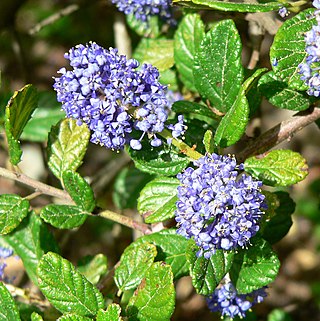
Ceanothus griseus is a species of flowering shrub known by the common names Carmel ceanothus and Carmel creeper. 'Carmel' refers to the Carmel-by-the-Sea region in California.

Fritillaria ojaiensis is a rare species of fritillary known by the common name Ojai fritillary.
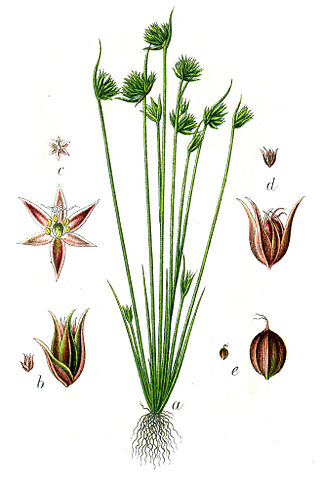
Juncus capitatus is a species of rush known by the common names dwarf rush and leafybract dwarf rush. It is native to Europe, Asia and North Africa. It is also an introduced species in parts of North America such as California and the Gulf Coast. It grows in moist areas, such as wet sand, vernal pools, and ditches.

Juncus confusus is a species of rush known by the common name Colorado rush. It is native to western North America from British Columbia to northern California to Colorado, where it grows in coniferous forests and wet, grassy areas such as mountain meadows. It is a bunching rhizomatous perennial herb which grows to a maximum height between 30 and 50 centimeters. Its thready leaves grow from the base of the light green stems to about 15 centimeters long. The inflorescence atop the stem is an array of individual flowers and there is a long bract at the base which may be up to 8 centimeters in length. Each flower has long, pointed tepals with dark and light longitudinal stripes and membranous, translucent borders. There are six stamens. The fruit is a light to dark brown oval-shaped or rounded capsule.

Juncus balticus subsp. mexicanus, synonym Juncus mexicanus, is a species of rush known by the common name Mexican rush. It is native to much of the west of the United States, Mexico and Central and South America. It is a plant of moist areas in a great number of habitats, from coast to desert to mountain and low to high elevation.

Juncus dubius is a species of rush known by the common name wrinkled rush. It is endemic to California, in the California Coast Ranges, Transverse Ranges, and southern Sierra Nevada. It is a common member of the flora in many wet areas, such as marshes and riverbanks.
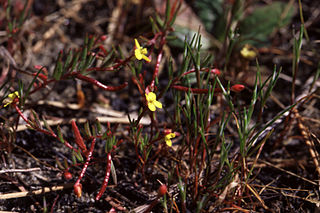
Camissonia strigulosa is a species of flowering plant in the evening primrose family known by the common name sandysoil suncup.
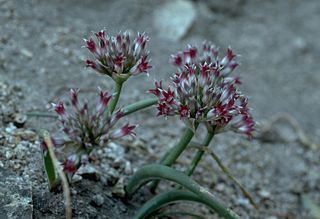
Allium monticola is an uncommon species of wild onion known by the common name San Bernardino Mountain onion. It is endemic to southern California, where it is found in the Transverse Ranges and the northernmost section of the Peninsular Ranges. It has been reported from San Bernardino, Los Angeles, Orange, Ventura and Santa Barbara Counties.

Arctostaphylos obispoensis is a species of manzanita, known by the common names bishop manzanita and serpentine manzanita, endemic to California.
Chorizanthe biloba is a species of flowering plant in the buckwheat family known by the common name twolobe spineflower. It is endemic to California, where it is known only from the Central Coast Ranges. There are two varieties, both of which are uncommon to rare.
Chorizanthe blakleyi is a rare species of flowering plant in the buckwheat family known by the common name Blakley's spineflower. It is endemic to the Sierra Madre Mountains of Santa Barbara County, California, where it is known from only eight occurrences, four of which are within the bounds of the Los Padres National Forest. It grows only on north-facing slopes in chaparral and woodland habitat. This plant grows upright to no more than 15 centimeters tall. It is yellow-green and hairy, with a few basal leaves up to about 2 centimeters long. The inflorescence contains several flowers, each surrounded by a tube of six hairy bracts with straight or hooked awns. The flower is a few millimeters wide with white or pink deeply notched tepals.
Chorizanthe obovata is a species of flowering plant in the buckwheat family known by the common name spoonsepal spineflower. It is endemic to California, where it grows in the mountains of the Central Coast Range from Monterey to Santa Barbara Counties.
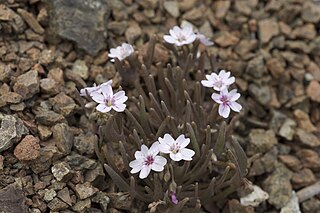
Claytonia gypsophiloides, known by the common names gypsum springbeauty and Coast Range claytonia, is a species of wildflower in the family Montiaceae.
Juncus triformis is an uncommon species of rush known by the common names Yosemite dwarf rush and long-styled dwarf rush.
Monardella palmeri is a species of flowering plant in the mint family known by the common name Palmer's monardella.

Phacelia grisea is a species of phacelia known by the common name Santa Lucia phacelia. It is endemic to California, where it can be found in the Santa Lucia Range and western sections of the Transverse Ranges.

Sidalcea hickmanii is a species of flowering plant in the mallow family known generally by the common name chaparral checkerbloom.

Smilax jamesii is a species of flowering plant in the greenbriar family known by the common name English Peak greenbriar. It is to northern California, where it is known from the Klamath Mountains and the southernmost peaks of the Cascade Range. It has also been reported from nearby locations in southwestern Oregon. It grows in moist areas such as lakesides and streambanks in mountain coniferous forest habitat. It was discovered to be a new species when herbarium specimens thought to be Smilax californica were reexamined.
Juncus digitatus is a rare species of rush known by the common name finger rush. It is endemic to Shasta County, California, where it is known from only two occurrences near Shingletown. It occurs in spring-moist habitat such as vernal pools in sunny locations in the foothills of the southernmost Cascade Range. The plant was first collected in 1991 and described to science as a new species in 2008.
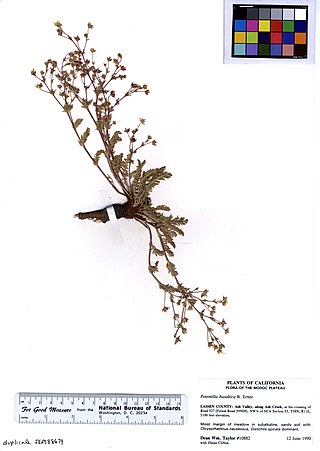
Potentilla basaltica is a species of flowering plant in the rose family known by the common names Soldier Meadows cinquefoil and basalt cinquefoil. It is endemic to a small area of the Modoc Plateau and Warner Mountains in northeastern California and northwestern Nevada.















